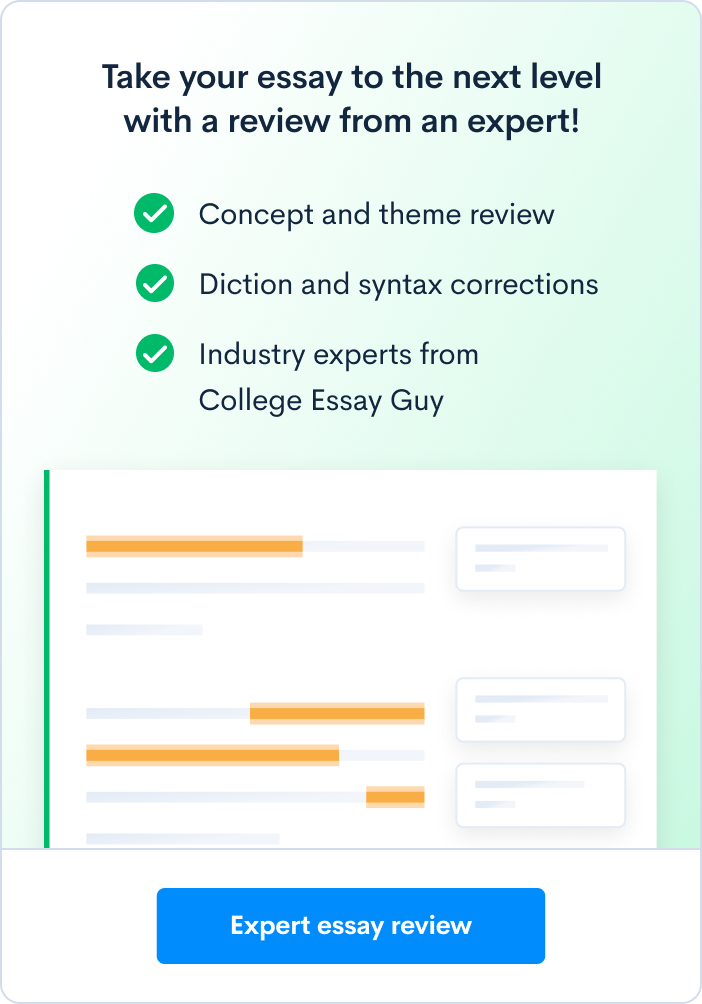2 Awesome UT Austin Essay Examples
The University of Texas at Austin is one of the hardest colleges to get into in Texas. With a competitive acceptance rate, the school is moderately selective. Writing strong essays, however, will certainly boost your chances. UT Austin requires one long essay and three short answers, with an additional optional short answer question. There are also a handful of program-specific prompts. In this post, we’ll analyze sample essays written by a real applicants, sharing what they did well and what could be improved. Please note: Looking at examples of real essays students have submitted to colleges can be very beneficial to get inspiration for your essays. You should never copy or plagiarize from these examples when writing your own essays. Colleges can tell when an essay isn’t genuine and will not view students favorably if they plagiarized. Read our UT Austin essay breakdown to get a comprehensive overview of this year’s supplemental prompts. Prompt: Using a favorite quotation from an essay or book you have read in the last three years as a starting point, tell us about an event or experience that helped you define one of your values or changed how you approach the world. Please write the quotation, title and author at the beginning of your essay (prompt from the 2020-2021 cycle). “Fortunately, among these people a man was judged according to his worth and not according to the worth of his father.” – Chinua Achebe, Things Fall Apart Like most children, I aspired to my father. I saw my dad as an image of whom I wanted to be. Charismatic, genuine, respected among his peers – he embodied the qualities I saw essential to being a successful person. The most appealing to me, however, was my father’s medical background. As the first person to attend university in our extended family, he had always been revered for his accomplishment of becoming a doctor. As a direct consequence, biology was a keen passion during my childhood. I remember how each evening, as I was being tucked into bed, I would unload an avalanche of questions on my dad, many of them amusingly simple such as: If my body is 70% water, why don’t I have water spilling out of my finger every time I get a papercut? In school, I’d stay after class to probe my teachers about the topics I had read of but did not yet comprehend. And anytime I was asked what I wanted to be when I grew up, I, without a whiff of doubt, bolted out I was going to be a doctor. However, as I got older, I developed new interests – in particular, social science and leadership – which did not always align with my childhood goals of medicine and biology. With this dichotomy in my mind, I decided to spend my sophomore summer volunteering at a hospital. Once there, it suddenly dawned on me that, for my entire life, I had viewed being a doctor through rose-tinted glasses since the reality of being a medical professional differed wildly from my perceptions. The dozens of biology textbooks I had read had not prepared me for a single drop of blood, as seeing just one could send me into an exhausting realm of dizziness. With every additional day of volunteering, it became painfully clear – I could not follow in my father’s footsteps. Disappointed, I began contemplating what made my experience in the hospital so bad and if anything could be done to improve people’s – whether patients’, doctors’, or volunteers’ like myself – experience. Then, a light-bulb switched on: what if I could improve the look of the hospital? As it stood, the hospital was incredibly run-down and inspired depression rather than hope. With a goal to improve the hospital’s appearance and thus create a friendlier environment for the people inside, I started the Better Setting – Better Getting project, which was going to decorate the hospital with photographs of nature. Having done so, there was a question of financing ー with the hospital administration over-budget, I had to source the funding entirely from the private sector. It was challenging but, a few dozen cold-calls and a handful of live-pitches later, I found a corporate partner that recognised my vision. Finally, I was ready to make my goal a reality. Legal roadblocks and printing nuances still stood in the way, but, with the enthusiastic support of the hospital community, I was able to navigate my way through. Today, dozens of wall-sized nature photos emit joy and hope into the halls of the hospital. My hospital volunteering, which had begun with heartbreak and disillusion, turned out to be a defining experience of self-discovery. It helped me close my chapter on medicine, a chapter I had so often doubted, and helped me validate my passion for leadership; it allowed me to operate free of doubt, knowing that I don’t have to follow my father’s footsteps. Above all, it made me realise that, although I would never be a doctor, I could nonetheless have a positive impact on society in my very own way. The author begins with a quote from a historical fiction novel that the author has read. Although their essay topic doesn’t tie directly in with the novel’s plot, the quote they chose is profound and serves as a hook that piques the reader’s interest about the essay subject. The author starts the essay by mentioning their father. Their use of first person and writing style makes their first lines seem like the narration at the beginning of a film. This introduction draws the reader in as it seems like the author is building up to something. Similarly, your introduction should start as if you are telling a story to provide the most engaging experience for the reader. The author then delves more into their father’s background and describes his medical prowess by showing, rather than telling, readers about it. Instead of saying that his father is exceptional, the author presents a specific detail about how he was the first in his family to attend university. Phrasing your writing like this allows the reader to infer through descriptive detail rather than simply absorbing your words at face value. Ensuring that you create this immersive writing style might take more time, but it is worth it as it will make your essay more memorable to admissions officers. Eventually, the third-to-last paragraph is the climactic point the reader has been waiting for. It is the most important part of the essay ー it’s time for the author to describe how they grew from the incident. During this portion of your essay, you should take readers through your thought process as you begin to formulate a solution for your conflict. It is not enough to say that you learned something new or to merely state that you felt like a changed person. You must provide concrete examples of how you reached a solution and what that solution entailed. Here, the author mentions their distaste for the hospital, specifically, its aesthetic. This sets readers up to hear their solution. In the next paragraph, the author describes how they resolved part of their issues with the hospital and were able to grow into their new career path. When detailing your solution, make sure you are centering yourself as the agent of change and give specific details as to your specific impact in your environment. In this essay, the author doesn’t just say “I learned that I had a passion for business.” Rather, they show readers how their skills developed and mention specific steps they took, like live pitching and navigating legal roadblocks. The author concludes this essay by summarizing their journey and bringing their essay back to their chosen quote. By wrapping up their essay in this manner, they underscore their growth in a way that flows well and is easy to read. Furthermore, their open-ended, future-facing final thoughts demonstrate that they intend to continue growing. This inclusion is a key part of any good essay; ending your essay on a strong, future-facing note evokes confidence and illustrates a readiness for the challenges that come with college and beyond. One area of improvement for this essay is that the section on their transformation is relatively brief. The author spends multiple paragraphs giving context but only dedicates one to the actions behind their growth. The author might want to trim other areas of the essay in order to fully develop this paragraph. They could describe what they did more thoroughly, and really delve into the steps they took to carry out the mentioned processes like so: My hospital volunteering, which had begun with heartbreak and disillusion, turned out to be a defining experience of self-discovery. It helped me close my chapter on medicine, a chapter I had so often doubted, and helped me validate my passion for leadership; it allowed me to operate free of doubt, knowing that I don’t have to follow my father’s footsteps. Above all, it made me realise that, although I would never be a doctor, I could nonetheless have a positive impact on society in my very own way. Prompt: Why are you interested in the major you indicated as your first-choice major? I woke up. The curtains filtered the sun rays, hitting my face directly. I got up, looked from the bathroom to the kitchen, but my dad wasn’t there. I plopped on the couch, then the door opened. My dad walked in, clutching a brown paper bag with ninety-nine cent breakfast tacos. After eating, we drove to a customer’s house. He sat me in a chair, lifted the floorboard, and crawled under the house to fix the pipes. As he emerged, he talked, but my mind drifted to the weight of the eleven-millimeter hex wrench in my hand. My interest in mechanical engineering originates from my dad, who was a plumber. When I was fifteen, my dad passed away from cancer that constricted his throat. Holding his calloused hand on his deathbed, I wanted to prevent the suffering of others from cancer. Two years later, when I was given a topic of choice for my chemistry research paper, I stumbled upon an article about gold nanoparticles used for HIV treatment. I decided to steer the topic of gold nanoparticles used for cancer treatment instead, entering the field of nanotechnology. After reading numerous articles and watching college lectures on YouTube, I was utterly captivated by topics like using miniscule devices to induce hyperthermia as a safe method of cancer treatment. Nanotechnology is multi-disciplinary, reinforcing my interest in pursuing mechanical engineering as a gateway to participate in nanoscience and nanotechnology research at the University of Texas at Austin. I have learned that nanotechnology is not limited to stories like mine, but to other issues such as sustainable energy and water development that I hope to work towards. It is important for me to continue helping others without forfeiting my interest in nanotechnology, working in collaboration with both engineering and the medical field. The introduction of this essay stands out for its narrative style. The first sentences only give hints of the story to come, which builds intrigue and keeps the reader engaged. The introduction transitions seamlessly into a vivid, personal story that shows where the author’s academic interests come from. Using a short anecdote like the one in this essay is the most effective way to explain your major choice. The author then guides readers through their intellectual journey of discovering their academic passions. They demonstrate their passion by discussing specific details about cancer treatments and nanotechnology. Indeed, “nerding out” over your intellectual interests is an excellent way to prove that you are highly motivated to learn about them in college. Lastly, the end of the essay looks forward to the future. We learn that the author’s dream is to cure cancer, and they want to do it by gaining multidisciplinary knowledge about engineering and medicine. We learn too that UT Austin is a part of the author’s vision. They show their interest in the school by discussing more than the major they want to pursue at UT Austin, highlighting research and the opportunity to explore new applications of nanotechnology. The main area for improvement in this essay is its formatting. While formatting is far less important than the content of an essay, it can do much more than you would think to make your essay more impactful. This essay only needs one formatting change — paragraph spacing. Here is an example of the improvements: I woke up. The curtains filtered the sun rays, hitting my face directly. I got up, looked from the bathroom to the kitchen, but my dad wasn’t there. I plopped on the couch, then the door opened. My dad walked in, clutching a brown paper bag with ninety-nine cent breakfast tacos. After eating, we drove to a customer’s house. He sat me in a chair, lifted the floorboard, and crawled under the house to fix the pipes. As he emerged, he talked, but my mind drifted to the weight of the eleven-millimeter hex wrench in my hand. My interest in mechanical engineering originates from my dad, who was a plumber. When I was fifteen, my dad passed away from cancer that constricted his throat. Holding his calloused hand on his deathbed, I wanted to prevent the suffering of others from cancer. Two years later, when I was given a topic of choice for my chemistry research paper, I stumbled upon an article about gold nanoparticles used for HIV treatment. I decided to steer the topic of gold nanoparticles used for cancer treatment instead, entering the field of nanotechnology. After reading numerous articles and watching college lectures on YouTube, I was utterly captivated by topics like using miniscule devices to induce hyperthermia as a safe method of cancer treatment. Nanotechnology is multi-disciplinary, reinforcing my interest in pursuing mechanical engineering as a gateway to participate in nanoscience and nanotechnology research at the University of Texas at Austin. I have learned that nanotechnology is not limited to stories like mine, but to other issues such as sustainable energy and water development that I hope to work towards. It is important for me to continue helping others without forfeiting my interest in nanotechnology, working in collaboration with both engineering and the medical field. This new paragraph spacing makes the essay much easier to read. Separating certain parts into paragraphs puts powerful emphasis on the ideas that need them; for example, turning the sentence “I woke up” into its own paragraph creates a captivating hook that intrigues readers into finding out what happens next. With the new format, it is also easier to see that the fourth paragraph would benefit from a few transitional phrases. To connect the author’s interests in mechanical engineering and cancer solutions, the paragraph could be reworded like so: My interest in mechanical engineering originates from my dad, who was a plumber. My interest in finding solutions to cancer — and how mechanical engineering could create them — comes from my dad too. When I was fifteen, he passed away from cancer that constricted his throat. Holding his calloused hand on his deathbed, I wanted to prevent the suffering of others from cancer. Do you want feedback on your UT Austin essays? After rereading your essays countless times, it can be difficult to evaluate your writing objectively. That’s why we created our free Peer Essay Review tool, where you can get a free review of your essay from another student. You can also improve your own writing skills by reviewing other students’ essays. If you want a college admissions expert to review your essay, advisors on CollegeVine have helped students refine their writing and submit successful applications to top schools. In fact, Alexander Oddo, an essay expert on CollegeVine, provided commentary on the essays in this post. Find the right advisor for you to improve your chances of getting into your dream school!
Essay Example #1
What the Essay Did Well
What Could Be Improved
Essay Example #2
What the Essay Did Well
What Could Be Improved
Where to Get Your UT Austin Essays Edited





